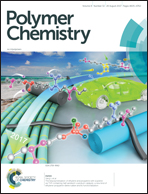Quinoxaline-based conjugated polymers for polymer solar cells
Abstract
Bulk heterojunction (BHJ) polymer solar cells (PSCs), as a promising alternative to conventional silicon-based solar cells, have achieved rapid development in recent years. In the BHJ concept, the active layer of the PSC normally consists of a blended film of a conjugated polymer donor and an electron acceptor. To be a conjugated polymer with OPV function, the polymer should have sufficient solubility, a broad absorption spectrum, a high absorption coefficient, and well-matched energy levels with the electron acceptor. With this aim, numerous conjugated polymers have been developed to date. Among them, quinoxaline-based polymers have been shown to have a promising future, reaching a very outstanding power conversion efficiency (PCE) of more than 11%, which shows that they have significant potential in reaching the efficiency limit of commercial applications of polymer solar cells. In this review, we summarize the quinoxaline-based conjugated polymers for efficient polymer solar cells by classifying them in terms of different donors, alkyl and/or aromatic chains, and functional groups, and we also give an overview of their photovoltaic device performances to provide a better understanding of and guidelines for the structure–performance relationship in such quinoxaline-based polymers. We believe that further developments of quinoxaline-based conjugated polymers achieved through the synergy of molecular engineering strategies will increase the photovoltaic performance to levels closer to those required for commercial applications in the near future.



 Please wait while we load your content...
Please wait while we load your content...